Orchids have long been prized for their beautiful blooms, but the recent rise of jewel orchids now offer an exciting alternative.
Instead of their flowers, these gorgeous species are coveted for their stunning leaves.
Honestly, like nothing I’ve ever seen before.
Perhaps more flashy than any other kind of plants – the foliage on offer ranges from dazzling gold lightning streaks to bold pink pinstripes.
Find out what makes jewel orchids so special, and how to grow your own!

Terrarium Tribe is reader-supported. When you purchase through links on our site, we may earn an affiliate commission (at no further cost to you). 💜
What are Jewel Orchids?
Aside from their unique beauty, the nature of jewel orchids runs deeper than their appearances.
Where most orchids are epiphytes (plants that grow on rocks and trees), jewel orchids are terrestrial plants found naturally on the rainforest floor.
Meaning these wee gems have evolved with very different wants and desires.
True to their classic orchid nature, they still bloom with some subtle white flowers, but it’s clear where they choose to direct their energy and fabulousness.
Jewel orchids are a perfect choice for year-round statement pieces.
Albeit small ones.
And with their size and beauty, they make excellent terrarium foreground elements!
Though they can be a little more challenging to grow than their common counterparts, with the right approach, they can be grown as houseplants and terrarium plants alike.
But first, let’s meet the prized jewels we’re talking about.
Types of Jewel Orchid
Ludisia dicolor
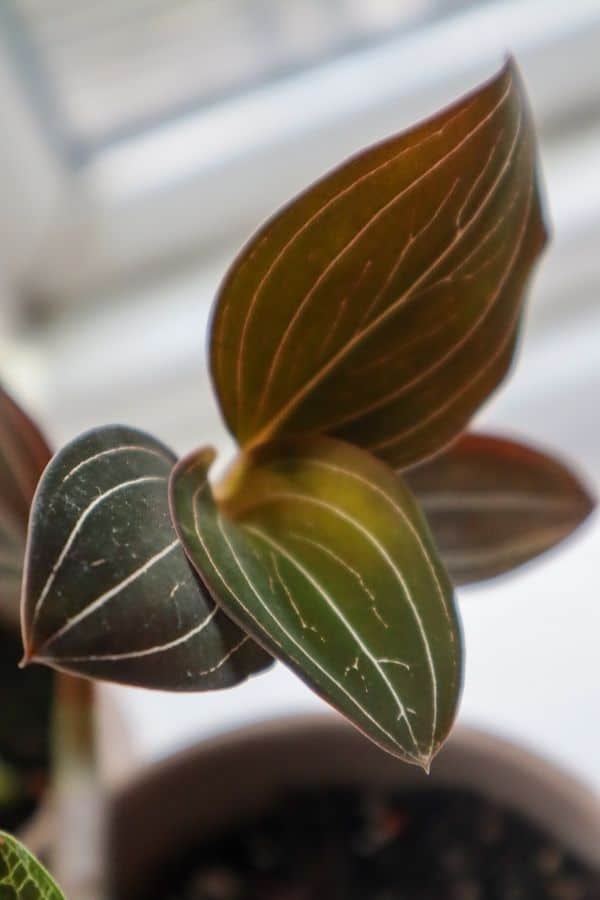
The name “Ludisia discolor” loosely translates to “of two colors.”
Referring to the bold pink pinstripes that pierce through the matte green leaves.
However, you’ll often see them simply called “Jewel Orchid” because they never picked up a unique common name (Pinstripe Plant was taken by Calathea ornata).
Perhaps because they’re the most widespread species of jewel orchid, people can falsely believe that they’re the only one of its kind. Which is a shame because the others really are special, too.
But, with Ludisia discolor easily being the most beginner-friendly of the jewel orchids, it makes sense as to why it’s become the popular houseplant it is today.
Macodes petola
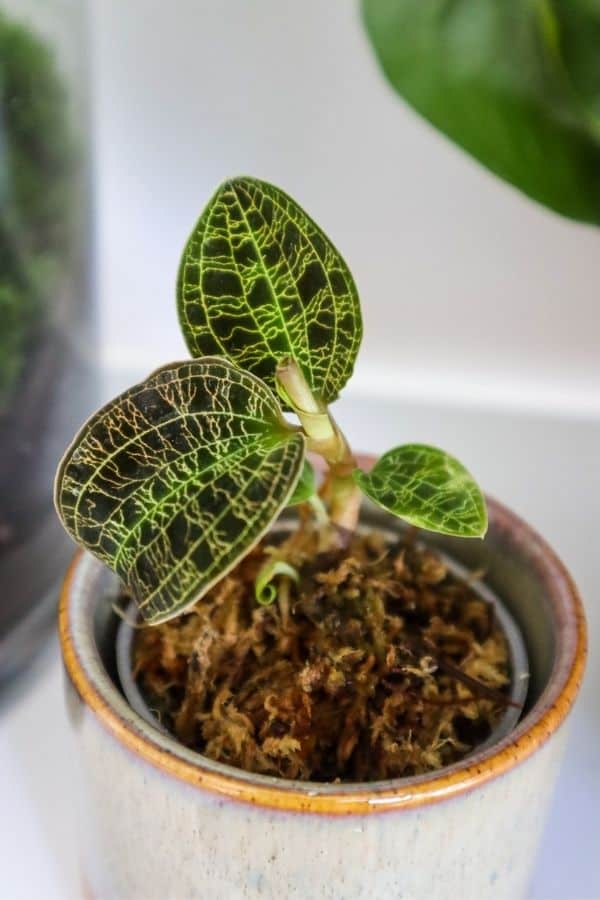
Found natively in a variety of Southeast Asian countries, the Lightning Jewel Orchid is rising fast in popularity around the world.
And if you’ve seen it… then there’s no surprise why.
The emerald green foliage with electric gold venation is simply breathtaking, and it literally shimmers in the light like a real jewel.
Cool right?
Macodes petola is a true prize for your plant collection, and thanks to modern in-vitro practices, they’re actually not too difficult to get a hold of anymore.
Anoectochilus
Within the Anoectochilus genus, there’s no clear standout species – but I’d say it’s a tossup between Anoectochilus chapaensis and Anoectochilus formosanus.
Both are similar to Macodes petola, but instead, they offer a selection of dark leaves.
The jet-black leaves contrast beautifully with the gold and bronze veins.
I’ve yet to add these jewels to my collection, but let’s just say that I’ve already purchased some perfectly petite glassware.
Jewel Orchid Care
Jewel orchids are a special breed, so there are a few key considerations to keep in mind.
Though they do have a reputation for being somewhat challenging, they’re not too difficult once you get the hang of them.
Get it right, and you’ll be rewarded with the most vibrant foliage of all.
Substrate
Substrate choice is perhaps the most challenging element of growing jewel orchids.
Not because they require any crazy specific mix but more so that a variety of things can work, and you just have to decide what fits you and your watering style best.
Jewel orchids need consistent moist conditions (light, not soggy), but root aeration is absolutely essential, too.
So, you’ll need a substrate mix with great water retention, aeration, and drainage. Which sounds more like an epiphyte mix, really, but there you go…
Though that sounds odd for a terrestrial orchid, it makes sense when you consider its native tropical forest floor is super loose and airy.
Substrate Mixes/Choices
Typical orchid mixes can a good starting point but they can also be lacking in water retention.
To balance this I’ve been trying my Ludisia discolor in a mix that’s half coconut coir (the water retaining element), and half succulent mix. So, it’s quite a granular blend with lots of horticultural sand, perlite, and grit for maximum drainage.
It’s doing great!
Alternative (and arguably more typical) aeration and drainage elements that you can add to a coco coir base include orchid bark chunks, fine lava rock, and pumice.
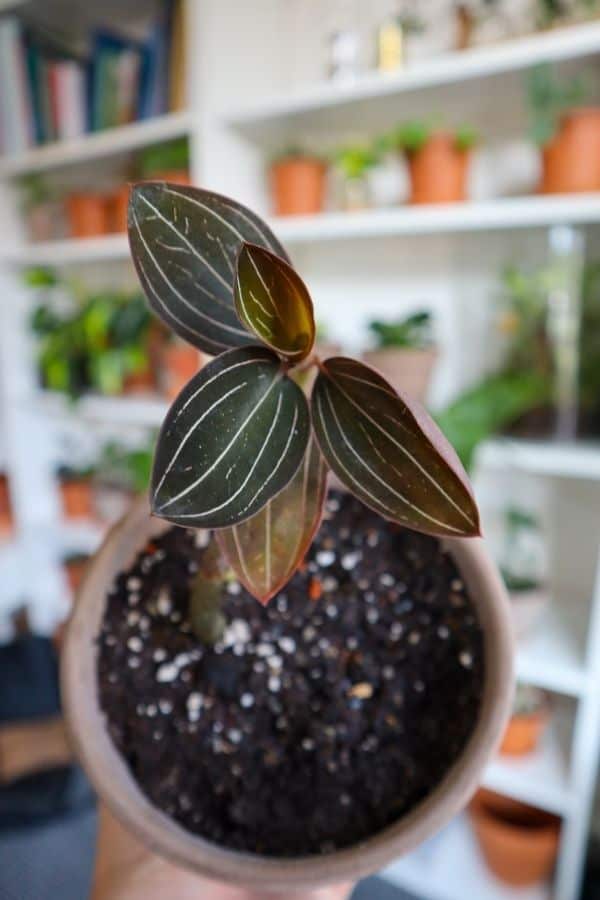
That being said, when you buy a jewel orchid, you’ll almost certainly receive it bundled up in pure sphagnum moss (and my Macodes petola is still like this for the moment).
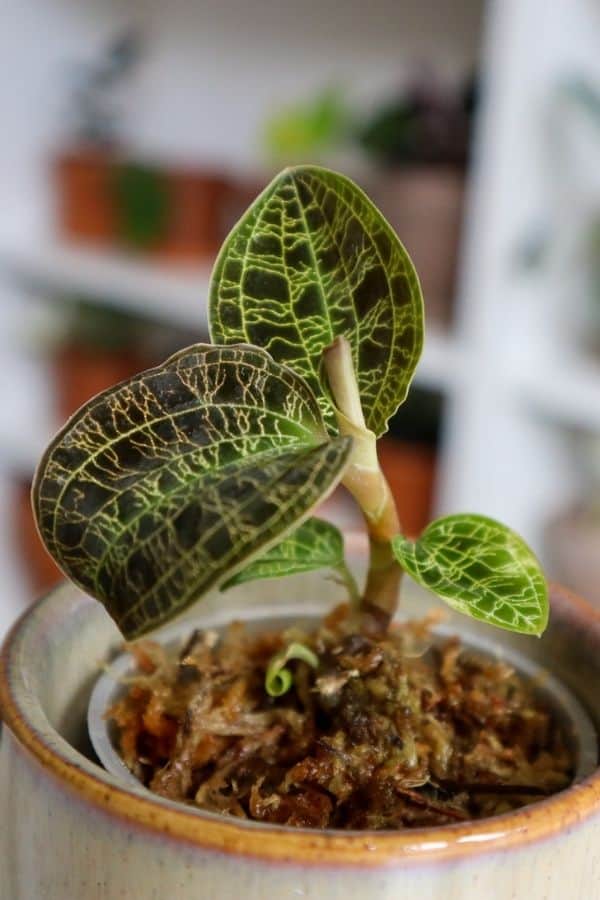
The consistent moisture and generous airflow that sphagnum moss provides make it a good fit. Check out my guide to sphagnum moss for more on why it’s so useful.
In fact, some people will grow them in heavy sphagnum moss mixes with good success (e.g. 50% sphagnum, 50% drainage elements) or even keep them in 100% sphagnum forever.
In an orchid terrarium, I don’t think you can go too wrong with a classic ABG mix or variant of it.
👉 Our premium terrarium substrate is a lovely mix of light and chunky.
Humidity and Temperature
Humidity is often touted as the be-all and end-all of jewel orchid care.
At the very least, the higher your humidity, the more wiggle room you have with your watering.
Personally, I think it’s important… but then the room I grow my plants in has a typical range that’s 70%+ most of the time. All I know is my plants are happy.
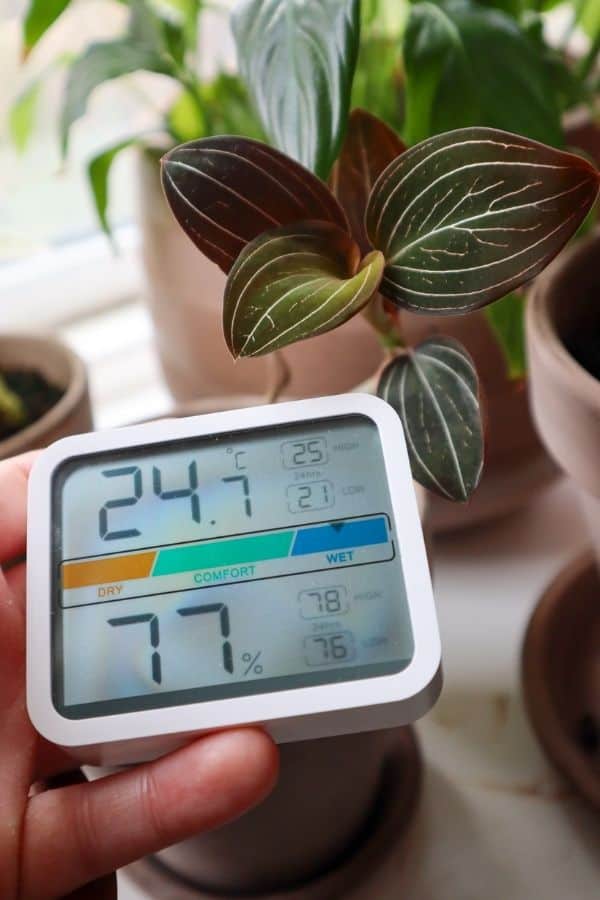
Jewel orchids are also known for being pretty sensitive to temperature swings, so providing stable warm temperatures and a humid environment is key.
Despite living in the cold North of the UK (and getting some chilly winter months), thanks to excessive use of central heating, we still maintain warm temperatures of around 25°C (77°F).
Using a pebble tray or placing watering cans around the room can help boost humidity, but growing your jewel orchids in a terrarium is by far the easiest way.
The only caveat here is that jewel orchids need airflow.
So, by all means, put them in a closed terrarium, but remember to take the lid off every now and again to get some fresh air in there.
To be honest, this is a good idea for most closed terrariums with tropical plants, but it’s pretty much essential with these orchids.
Watering
Your watering schedule and technique are going to be largely dependent on your substrate choice.
You’ll want to aim to keep your jewel orchids lightly moist at all times, but of course, some mixes dry out faster than others.
Sphagnum-heavy blends will hold moisture for a long time (and if your humidity is high, too, you’re not going to need to water often at all).
Conversely, coarser mixes or those heavy in perlite are going to drain and dry much quicker.
In a terrarium, achieving a water balance with a lightly moist environment is best. Start low and work your way up, spray by spray.
Remember, you’ll be opening it up semi-regularly, so you’ll have plenty of opportunities to add more water later.
Light
As you might expect from tiny plants found on the rainforest floor, jewel orchids are not accustomed to getting much light.
Just dappled light that’s managed to break through the canopy and reach right down to the bottom.
In the home, we’d call that bright indirect light.
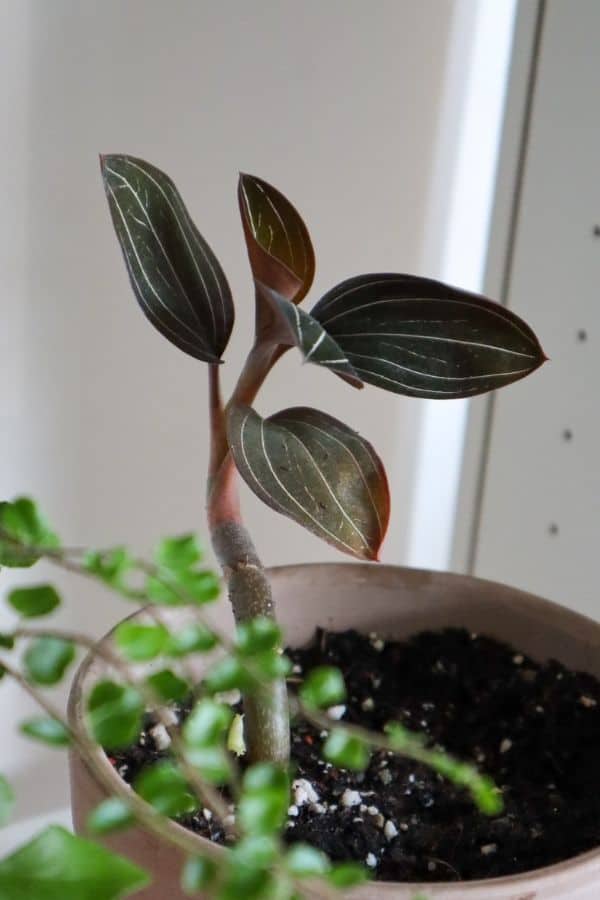
The brighter the light, the more vibrant the foliage.
Just not direct light, that’s a rapid way to have a crispy dead orchid on your hands…
Grow lights can be super helpful to provide maximum light without the risk of damage – and are great for terrariums in general – but in the home, a North-facing window would be best.
Propagation
Propagating jewel orchids is actually a pretty straightforward process,
Much like our much-loved aroids, jewel orchids can be propagated through stem cuttings.
Find a juicy-looking stem on the mother plant, identify the node, and then cut just behind it.
These cuttings can be popped directly into water to root up.
Though they don’t root up rapidly, with a bit of patience (at least a month), you’ll have some new individual plants you can pot up.
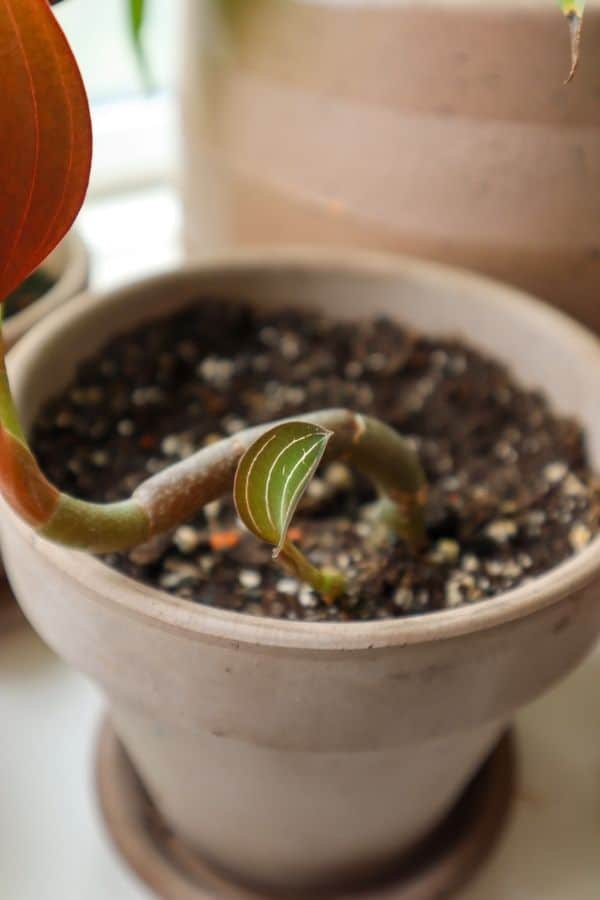
Growth
Jewel orchids do vary in size and growth habits.
The stunning foliage of Macodes patola tends to spread out (and if it’s really healthy, it somehow gets denser at the same time), whereas Ludisia forms much larger and more structured plants.
Being slow growers overall, I don’t feel the need for liquid fertilizers very often.
Just some slow-release nutrients from earthworm castings are usually enough in my experience.
When it comes to the modest white blooms, some people like to pinch them off to direct the plants to direct their energy to their foliage instead.
I think they’re quite pretty, personally!
Where to Find Jewel Orchids for Sale
I like to find most of my plants on Etsy.
It’s always interesting to see new varieties pop up with interesting and beautiful foliage.
👉 Check out the range of Jewel Orchids on Etsy.
Frequently Asked Questions
Some jewel orchids are still considered rare, but many are becoming readily available thanks to modern propagation techniques. You can easily get your hands on the three main species.
Jewel orchids are definitely classed as orchids. They are unique in that they’re terrestrial plants, whereas other orchids are epiphytes.
Jewel orchids do need high humidity, but you can offset some of that requirement with proper watering and care.
Over to You
Are you sold on the beauty of jewel orchids?
Which one’s your favorite? Let me know in the comments!

I have had a Jewel orchid for many years and it brings flowers every winter, usually at Christmas time. A few weeks ago small white insects appeared on it. They leave a sticky residue on and around the plant. How can I get rid of them?The plant still has many new blooms which are growing, but the leaves are getting a reddish discoloration.
Sounds like mealybugs I’m afraid. Lots of people recommend dabbing them with isopropyl alcohol using a cotton swab.
Thank you for this article. As a newB to plants and proud new mom to a lightning jewel orchid, I was glued to your words. Can’t wait to see what happens!
I have used quality Jiffy peat compost with good results. It has good water retention and air filled porosity. Adding gravel to compost can reduce AFP and be self defeating unless enough to stack up onto of itself.
I have a very old jewel orchid. It’s more than 50 years old.